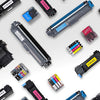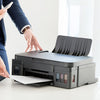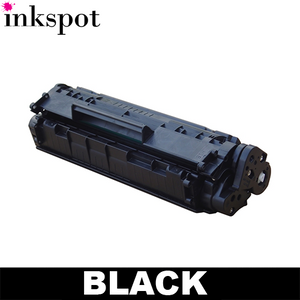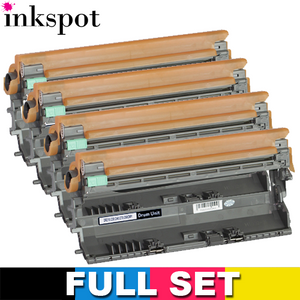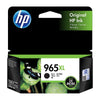Inkjet vs Laser: Which Printer Is Right For You?
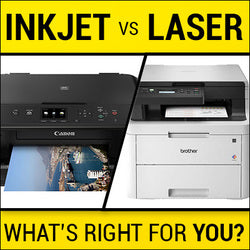
You’re stuck at a crossroads asking: should you get an inkjet or laser printer? Many consumers have asked the very same question and in this article we should be able to help you figure out which is right for you.
Whether or not you need an inkjet or laser printer would depend on what you print, how often you print, and how much your printing budget is.
The Basics
Inkjet printers are generally cheaper, smaller, and have the versatility to print both text-based documents and high quality images, especially photos. BUT be wary of cheap inkjet printers as those will end up costing you a fortune later on.
Laser printers on the other hand, may be expensive upfront and use pricier toner cartridges, but still offers an overall lower cost per page, faster print speeds and typically involve a lower total cost of ownership.
Let’s take a closer look at the strengths and weaknesses of laser and inkjet printers so you can make your next purchase with confidence.
What Will You Use the Printer for?
If you’re looking for a home printer for occasional printing, most people would advise you to get an inkjet printer. This can also be a disadvantage though as a common complaint with inkjet printers is that the ink dries up if you don’t use it often. However, if you’ll be printing a small volume of documents and coloured images regularly, inkjet printers will get the job done. With that said, if you have the budget for it I strongly suggest you get an affordably priced laser printer instead; the toner used by laser printers doesn’t dry up.
Laser printers are known to be more durable and can print large quantities of black and white and coloured documents frequently. Though laser printers were originally built for office use, they are now growing in popularity as a home printer for economical reasons.
What about for printing in colour? Colour laser printers are good for everyday colour printing but if you’re looking to print professional high resolution photos, go with a photo inkjet printer. High quality photo inkjet printers are specially engineered to produce vividly detailed photos with the tonal variety and deeper blacks that photographers and creatives need. Many professional photo inkjet printers use pigment-based ink which is more fade-resistant and works with a wide variety of art paper types as well as a range of paper sizes but you can also find dye-based photo inkjet printers if you don’t require the longevity of pigment ink.
So for colour printing the inkjet vs laser argument boils down to what you need colour printing for:
- If you need gallery quality photos, get a photo inkjet printer.
- But if you need to print medium quality coloured images that don’t require colour depth and tonal range, we recommend colour laser printers over inkjet printers for two reasons: 1) laser toner does not dry up if left unused and 2) you print more pages from laser toner cartridges than inkjet cartridges
Technology (How It Works)
Inkjet printers spray liquid ink through microscopic nozzles onto paper whereas laser printers have a drum unit that fuses toner powder onto paper with heat.
So, one printer type uses ink, the other uses powder. With this difference in application between the two inkjet and laser printer types, it’s a common belief that smudging is more common with inkjet printers than laser. That’s not to say all inkjet printers do. Inkjet printers that use pigment based ink aren’t likely to smudge whereas dye-based ink require a longer drying time for the ink to set. And this also depends on what paper you’re printing on. Some paper types absorb ink better while some don’t.
Print Quality
Print quality depends on the output you need. If you need to print vivid exhibit-quality photos, look for a good professional photo inkjet printer that produces high resolution images. If what you need is a reliable printer that can keep printing sharp documents, a laser printer is what you need.
A common perception is that inkjet printers are better with coloured images, and laser printers are best for black and white. New colour laser printer models in the market today beg to differ. Advancements in printer technology have allowed colour laser printers to now produce pretty impressive coloured photos as well. Although inkjet printers still win over laser when it comes to highly detailed and perfectly-toned photographic prints, colour laser printers are now an option to consider for those looking to print medium-quality coloured images while enjoying the reliability, endurance, and economic benefits of a laser printer.
In a nutshell:
- Monochrome Laser printers: Excellent for text and documents
- Colour Laser Printers: Excellent for text, documents, and can print medium-quality colour images (ie. family photos for personal use).
- Photo Inkjet Printers: Great for printing high quality photos with wide colour range and tonal depth. Best when printing photo gallery prints.
Print Speed
Laser printers are built to accommodate the demands of a workplace so they are engineered to print faster (between 15 to 100 pages per minute, or ppm), while inkjet printers print slower at about 16 ppm. Since laser printers are faster, they are able to produce more documents compared to inkjet printers and therefore have a higher monthly print volume.
- Laser Printers: 15 to 100 pages/minute
- Inkjet Printers: 16 pages/minute
Print Volume
Print volume refers to how much your printer can print at a given time. A laser printer is considered to be the workhorse of the office because of its capability to quickly print large amounts of documents. Given that inkjet printers are meant for home use it’s print volume is significantly smaller.
For comparison, let’s take a look at the HP LaserJet Pro MF254’s print volume and speed alongside the HP Deskjet MFC3720 inkjet printer.
|
HP LaserJet Pro MF254NW |
HP Deskjet MFC3720 (inkjet) |
|
|
Pages Per Minute |
16 ppm |
8 ppm |
|
Monthly Duty Cycle |
30,000 pages |
1000 pages |
Notice the stark contrast between the print speed and duty cycle between the two printer types. And for those unsure, the maximum monthly duty cycle is how much your printer can print in a month without causing damage to its parts. Printing at maximum monthly duty cycle can result in your printer calling it quits much sooner than you expect. Try to stay within the recommended monthly print volume instead to keep your printer around longer.
Printer vs Cartridge Cost
The upfront cost of a laser printer may seem like its biggest weakness. After all, inkjet printers have a much lower upfront cost with newer models priced as low as $29.99 while laser printers are significantly more expensive with the cheaper ones priced at around $59.99–still twice the price of the cheapest inkjet.
But beware of dirt cheap inkjet printers. These cheap models have a high cost per page and use cartridges that can print only a few hundred pages that you’ll end up having to replace cartridges frequently. Before you know it, you’ve already spent more on ink cartridges than the printer itself.
When compared with laser printers, inkjet printers have a lower price partly because inkjet printers have a shorter minimum life span compared to laser printers (generally 3 years vs 5 years), and this is all depends on frequency of use.
A more important factor to consider when shopping for a printer is its cartridge price.
In the same way that inkjet and laser printers widely differ in price, cartridge prices for a laser and inkjet printer also widely differ — and for good reason. Laser printer cartridges, also known as toner cartridges, can print significantly more pages than any inkjet cartridge!
Using the two printers we used previously as an example, the HP LaserJet Pro MF254NW uses the HP 204a toner cartridges, the black toner can print up to 1,100 pages while the HP Deskjet MFC3720 inkjet printer uses the HP 63XL which prints up to 300 pages. Compare 1,100 pages vs 300 pages! An HP 204a cartridge costs $90.00 (as of 15/05/19) and the HP 63XL cartridge currently costs around $53.22. Although the HP toner is almost double the cost of the inkjet cartridge, since you get almost 4 times as many pages out of the toner, the HP laser cartridge has a more economical cost per page. Check out the table below.
|
HP LaserJet Pro MF254NW |
HP Deskjet MFC3720 (inkjet) |
|
|
Cartridge |
HP 204a |
HP 63XL |
|
Page Yield |
1,100 pages |
300 pages |
|
Cost |
$90 (as of 15/05/19) |
$53.22 (as of 15/05/19) |
|
Cost per page |
8.2 cents per page |
18 cents per page |
The toner cartridge actually ends up costing you less than half then what the ink cartridge does!
If the price of laser toner is too steep for you, consider trying more affordable toner cartridge alternatives in the market.
Compatible ink and toner cartridges are widely available at much better prices and print just as well as expensive branded cartridges.
For comparison purposes, let’s take the pricing of an original HP 204a cartridge and compare it with the Inkspot compatible version.
Original HP 204a Cartridge: $90.00
Compatible HP 204a Cartridge: $69
You can get big discounts on compatible ink cartridges as well. Thanks to aftermarket options, expensive printer cartridges is now a thing of the past.
The upfront cost of an inkjet printer might seem the more economical (and attractive) choice at first but when you take into account the price of ink cartridges AND how often you’ll have to replace them (considering its low page yield), the running cost of replacing cartridges will easily get much more expensive than the initial cost of the printer.
On the contrary, laser printer cartridges can print more pages so it will be months or even years before you’ll need replacements, again depending on how much you use your printer.
Mind the Drum Unit
Another difference between inkjet and laser printers is that for inkjet printers you only need ink cartridges to print, while for laser printers, you need a toner cartridge and a drum unit. Laser printers always come with a drum unit that transfers the toner powder onto paper. The toner and drum unit are the two consumables required for a laser printer to work. Sometimes they come together as one piece and sometimes there are models where they come separately. Some brands of laser printers have toner cartridges with an integrated drum unit like HP. Brother laser printers on the other hand have a toner cartridge and a separate drum unit. When shopping laser printers, make sure to check if you’ll be needing to replace the toner cartridges AND the drum unit (though you only need to replace the drum unit a lot less frequently than the toner). Don’t let this turn you off laser printers though. You will only rarely need to replace the drum unit–usually every 4-5 toner cartridges.
Inkjet Printers
PROS
- Inkjet printers are usually smaller and lighter – making it ideal for a bedroom or home office where space saving is valued.
- Great at producing photo quality prints and image-heavy documents, as inkjet printers do a better job of blending and producing vibrant colours than laser printers.
- The price of an inkjet printer is less than most laser printers.
- Can print on a variety of paper types, including glossy photo paper, textured art paper, and fabrics.
- Can accommodate larger paper sizes.
CONS:
- Ink is expensive, especially for users who print on a regular basis who are continually forced to repurchase more cartridges because ink cartridges can only print a few hundred pages.
- Much slower than laser printers.
- Low-capacity paper trays of 50 to 100 sheets, which can be frustrating for a user who prints a lot.
- Low monthly duty cycle (the maximum amount of prints possible in a given month without causing damage to the printer).
Laser Printers
PROS:
- Most laser printers print much faster than inkjet printers. This isn’t and shouldn’t be a strong selling point for casual printers, but high volume users will notice a huge difference.
- Laser printers produce sharp text. If you’re a high volume printer that only requires text documents, laser is the way to go.
- Higher monthly duty cycle means they are better prepared to handle high-volume jobs.
- A price-by-price comparison favors laser printers over inkjet printers if you print on a frequent basis and aren’t producing documents that are graphically complex.
- Toner, on average, is cheaper in the long run for high volume printers because their cartridges can print out thousands of pages in comparison to ink cartridges.
CONS:
- Can handle simple graphics, but complex images and photos are a challenge.
- Although there are some compact laser printers on the market, they are generally bigger and heavier than inkjet printers.
- Laser printers can’t handle the same variety of paper that inkjets can.
- The upfront cost of a laser printer is usually more than your average inkjet printer.
Deciding on whether you should go with an inkjet or laser printer comes down to what you print, how much you print, and how much you’re willing to spend on printing. Inkjet printers are best suited for small, image-heavy documents, like photos and school projects. But, if you’re looking for a printer that can handle heavy volumes of text-based documents, a laser printer is the more efficient and economical choice. It also pays to think farther down the road.
Do you project your print needs to change? Will your kids be needing a more reliable laser down the road or should you stick to an inkjet printer? Our needs change and taking them into consideration can save us potentially hundreds of dollars in the future.
Happy Shopping!
-
Posted in
Latest Articles

 Ink Brands
Ink Brands 